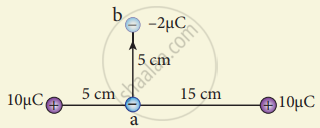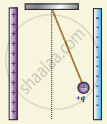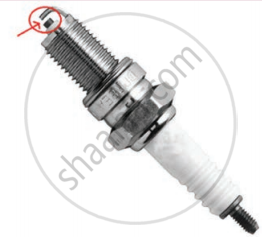Advertisements
Advertisements
प्रश्न
A point charge of +10 µC is placed at a distance of 20 cm from another identical point charge of +10 µC. A point charge of -2 µC is moved from point a to b as shown in the figure. Calculate the change in potential energy of the system? Interpret your result.

उत्तर
q1 = 10μC = 10 x 10-6 C
q2 = 2μC = -2 x 10-6 C
distance, r = 5cm = 5 x 10-2 m
Change in potential energy,
`Delta "U" = (9 xx 10^9 xx 10 xx 10^-6 xx (- 2 xx 10^-6))/(5 xx 10^-2)`
= -36 × 1 × 109 × 10-12 × 102 = -36 × 10-1
∆ U = -3.6 J
Negative sign implies that to move the charge -2pC no external work is required. The system spends its stored energy to move the charge from point a to point b.
∆ U = -3.6 J, negative sign implies that to move the charge -2μC no external work is required. System spends its stored energy to move the charge from point a to point b.
APPEARS IN
संबंधित प्रश्न
Rank the electrostatic potential energies for the given system of charges in increasing order.

A thin conducting spherical shell of radius R has a charge Q which is uniformly distributed on its surface. The correct plot for electrostatic potential due to this spherical shell is
Two points A and B are maintained at a potential of 7 V and -4 V respectively. The work done in moving 50 electrons from A to B is ______.
What is an equipotential surface?
Give the relation between electric field and electric potential.
What is meant by electrostatic energy density?
Derive an expression for electrostatic potential energy of the dipole in a uniform electric field.
Draw the free body diagram for the following charges as shown in the following figure.

Draw the free body diagram for the following charges as shown in the following figure.

A spark plug in a bike or a car is used to ignite the air-fuel mixture in the engine. It consists of two electrodes separated by a gap of around 0.6 mm gap as shown in the figure.

To create the spark, an electric field of magnitude 3 x 106Vm-1 is required,
- What potential difference must be applied to produce the spark?
- If the gap is increased, does the potential difference increase, decrease or remains the same?
- Find the potential difference if the gap is 1 mm.
